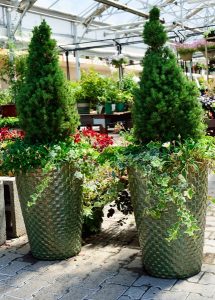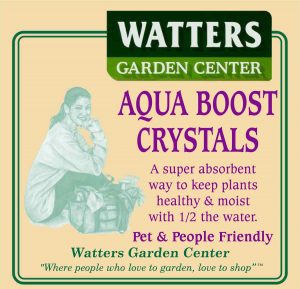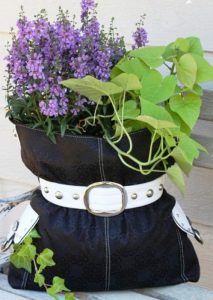by Ken Lain, the mountain gardener

Whether you are new to container gardening or have years of experience; there probably is something you’ll find valuable in this article. In order of which they are most often encountered, here are the top 10 blunders made when putting together mountain container gardens:
Filling a Large Container in the Wrong Place – Planters are cumbersome once they are filled with potting soil and plants, but large containers can be overwhelmingly heavy. Place the empty container on a wheeled plant caddy before filling with soil. This is especially important when you plan to bring containers close to the house in winter or change locations as the garden sun shifts during the growing season.
Using Sick and Weakly Plants – Buying at a reputable garden center is the right place to start in your quest for healthy plants. You have a better chance of getting plants that have known better care and are more apt to be disease and pest free than at a Mart or big box store. Also, you will have ready access to a wealth of information and advice from a gardening-knowledgeable staff. Don’t be afraid to ask an employee to help you pick out the perfect combination of plants.
Overwatering Plants – Overwatering is a common cause of plant death in new container gardens. All containers must have a drainage hole to allow the escape of excess water. Invest in a moisture meter to use before watering containers. Signs of overwatering are leaves that turn yellow and fall off or plants that become limp. If soil is too wet, move the pot to a dry, breezy spot until excess moisture has dried away.
Underwatering Plants – To be properly watered, a container garden’s irrigation should run until the water is dripping out the drainage hole in the bottom of the pot. In the heat of June and July water may be needed every day for hanging baskets and small bowls. Larger containers may be able to go several days before rehydration is required. Again, a moisture meter is good help.

Aqua Boost Crystals – Consistent water is the secret to spectacular container gardens. If your bloomers get even a bit dry, they sacrifice flowers to keep the core of the plant healthy. Sprinkle a tablespoon of ‘Aqua Boost Crystals’ at the bottom of each planting hole. Add more crystals just below the soil’s surface to keep plants evenly moist and continually blooming. These exceptionally absorbent crystals regulate the moisture to each plant, encouraging more substantial roots for longer lasting flowers in containers. I never plant without a little Aqua Boost for each new plant in the garden.
If your plants do dry out, don’t despair; even the most pathetic, limp plant might revive with a good drink. If the container is small enough, submerge the entire pot in a bucket of water until the air bubbles subside. For large containers, take a skewer or stick and gently poke holes deep into the soil to allow water to reach the roots. Then, water generously.
Awkward Plant to Pot Ratio – Make sure to consider the proportions of your plants to your container. For example a large bowl stuffed with short plants appears low growing and stunted. Two good design rules for planting a container garden: 1) use at least one plant that is as tall as the container. 2) use trailing plants at the perimeter of the edge to spill over the sides.
Fear of Pruning – When your container plants start looking leggy or heat-worn, don’t be afraid to cut them back … way back. Chances are that when they come back they’ll be healthier, happier, and full of blooms.
Selecting Plants With Different Requirements – Make sure all the plants in each container garden share the same sun, soil, and water requirements. A garden center’s signs and plant tags will have this information. If you doubt your ability to make these choices, ask a plant ambassador at the garden center for an assist.
Starving Your Plants – Good potting soil has a 5-5-5 organic plant food already mixed into the soil. This encourages fast new growth but is flushed out of the soil within a couple of weeks. After two weeks start feeding your container gardens with Flower Power 54 twice per month. This highly concentrated food produces more mountain flowers and fruits in containers than any other fertilizer. Be sure to steer clear of salt-based fertilizers like Miracle Grow.
Living With Ugly – Plants have definite lifecycles. When a plant looks terrible, and you cut it back hard, and it’s still ugly: pull it out of your garden and replace it with a fresh new one. The plant may be sick or it simply doesn’t enjoy the current growing season that is either too hot or too cold for that specific plant. Don’t live with ugly in your containers; pull that individual plant out and replace it!
Having Unrealistic Expectations – Before creating new containers, evaluate how you live. If you travel often, use self-watering pots, add automatic drip irrigation, or hire a competent plant sitter. You also can try planting super-hardy natives with a uniquely Southwestern twist like agave, yucca, manzanita, succulents, and cacti. All are very forgiving when irrigation is lacking.
Pinterest Board – This year’s Lain Casa container gardens.
 Garden as You Live –Plant within your unique style. Some people like clean, well-planned, organized containers. Others like wild and free containers spilling over with frenzied abandon. Neither is better than the other; each with lots of room for learning from errors. Have fun and experiment when imagining and creating these gardens. Whatever your personality, you can create container gardens that are sources of joy and bring beauty to your home.
Garden as You Live –Plant within your unique style. Some people like clean, well-planned, organized containers. Others like wild and free containers spilling over with frenzied abandon. Neither is better than the other; each with lots of room for learning from errors. Have fun and experiment when imagining and creating these gardens. Whatever your personality, you can create container gardens that are sources of joy and bring beauty to your home.
Until next issue, I’ll be helping gardeners create the perfect container gardens here at Watters Garden Center.
Ken Lain can be found throughout the week at Watters Garden Center, 1815 W. Iron Springs Rd in Prescott, or contacted through his web site at WattersGardenCenter.com or FB.com/WattersGardenCenter .

